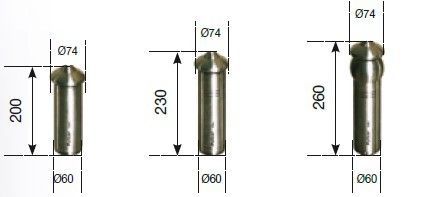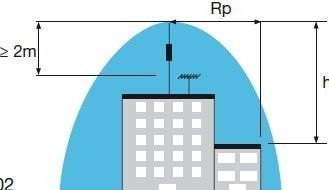Helita Pulsar E.S.E Lightning Conductor

Product Name:Helita Pulsar E.S.E Lightning Conductor
Product Model:Pulsar 30,Pulsar 45,Pulsar 60
Updated:2010.03.29
Views:3

PULSAR
PULSAR, THE HIGH PULSE VOLTAGE E.S.E. LIGHTNING CONDUCTOR
OPERATING PRINCIPLEWhen the lightning approaches the ground, a luminous ascending brush discharge is initiated at the lightning conductor. In the case of a Franklin rod, this ascending brush discharge propagates in the direction of the descending leader after a long transition phase. The Pulsar initiation advance permits to reduce the required time for the formation and continuous propagation of the ascending discharge and brings thus a higher efficiency for the lightning capture than a Franklin rod tip.
AN EFFICIENT INITIATION ADVANCEThanks to its initiation advance, the Pulsar emits a high voltage signal at clearly determined and controlled frequency and amplitude. Its effectiveness is guaranteed by the rapid formation and propagation of the upward leader, while reducing the development of space charges around the point.
ENERGY AUTONOMYThe Pulsar is also self-contained. It draws its energy from the ambient electric field existing at the time of the storm (10 to 20 kV/m). The initiation advance starts up as soon as the ambient field exceeds a peak value which corresponds to the minimum lightning stroke risk.
Operation of a PULSAR1 . The Pulsar tip plays a triple role:
- Collect the energy necessary to power the electrical device contained in the cylinder,
- Emit the brush discharges created by the high-voltage pulses,
- Capture the lightning current to convey it to the ground. The metal disc is the upper part of the external air gap designed to convey the lightning current from the tip to the ground.
The metal cylinder contains the electric device of the Pulsar system that generates the brush discharges.
The pole serves to fix the Pulsar for installation.
The connecting clamp must be fixed to it, together with the down conductor.
1 Tip 75 cm long and 18 mm diameter.
2 Metal disc with variable diameter and thickness for the different Pulsar models.
3 Metal cylinder containing the early streamer emission device.
4 Pulsar pole outside diamètre 30 mm.
5 Connecting clamp to fix the down conductor.
Pulsar references
| ΔT (μs) |
Description | Reference | L(m) | Weight (kg) |
| 30 | Pulsar 30 stainless steel 2 m Lightning conductor | HO IMH 3012 | 2.0 | 5.0 |
| 45 | Pulsar 45 stainless steel 2 m Lightning conductor | HO IMH 4512 | 2.03 | 5.3 |
| 60 | Pulsar 60 stainless steel 2 m Lightning conductor | HO IMH 6012 | 2.06 | 5.7 |




l’équipement éléctrique, du contrôle-commande et des services associés, Group of Industries forMaterials for Electrical Equipment and associated Industrial Electronics).

Rp : Radius of protection in a horizontal plane located at a
vertical distance h from the Pulsar tip
h : Height of the Pulsar tip above the surface(s) to be
protected
D : Standardized striking distance
ΔL = 106 .ΔT (initiation advance)
Rp : √ h (2D - h) + ΔL (2D + ΔL) (for h ≥ 5 m)
For h < 5 m, refer to the table below
ΔT = Initiation advance measured during efficiency tests
according to Annex C of French standard NF C 17-102
Pulsar radius of protection
| Level of protection | I (D = 20 m) | II (D = 30 m) | II (D = 45 m) | II (D = 60 m) | ||||||||
| Pulsar | Pulsar30 | Pulsar45 | Pulsar60 | Pulsar30 | Pulsar45 | Pulsar60 | Pulsar30 | Pulsar45 | Pulsar60 | Pulsar30 | Pulsar45 | Pulsar60 |
| h (m) | Radius of protection RP (m) | |||||||||||
| 2 | 19 | 25 | 32 | 22 | 28 | 35 | 25 | 32 | 40 | 28 | 36 | 44 |
| 3 | 28 | 38 | 48 | 33 | 42 | 52 | 38 | 48 | 59 | 42 | 57 | 65 |
| 4 | 38 | 51 | 64 | 44 | 57 | 69 | 50 | 65 | 78 | 57 | 72 | 87 |
| 5 | 48 | 63 | 79 | 55 | 71 | 86 | 63 | 81 | 97 | 71 | 89 | 107 |
| 6 | 48 | 63 | 79 | 55 | 71 | 87 | 64 | 81 | 97 | 72 | 90 | 108 |
| 8 | 49 | 64 | 79 | 56 | 72 | 87 | 66 | 83 | 99 | 75 | 92 | 109 |
| 10 | 49 | 64 | 80 | 57 | 72 | 88 | 66 | 83 | 99 | 75 | 92 | 109 |
| 15 | 50 | 65 | 80 | 58 | 73 | 89 | 69 | 85 | 101 | 78 | 95 | 111 |
| 20 | 50 | 65 | 80 | 59 | 74 | 89 | 71 | 86 | 102 | 81 | 97 | 113 |
| 45 | 50 | 65 | 80 | 60 | 75 | 90 | 75 | 90 | 105 | 89 | 104 | 119 |
| 60 | 50 | 65 | 80 | 60 | 75 | 90 | 75 | 90 | 105 | 90 | 105 | 120 |
